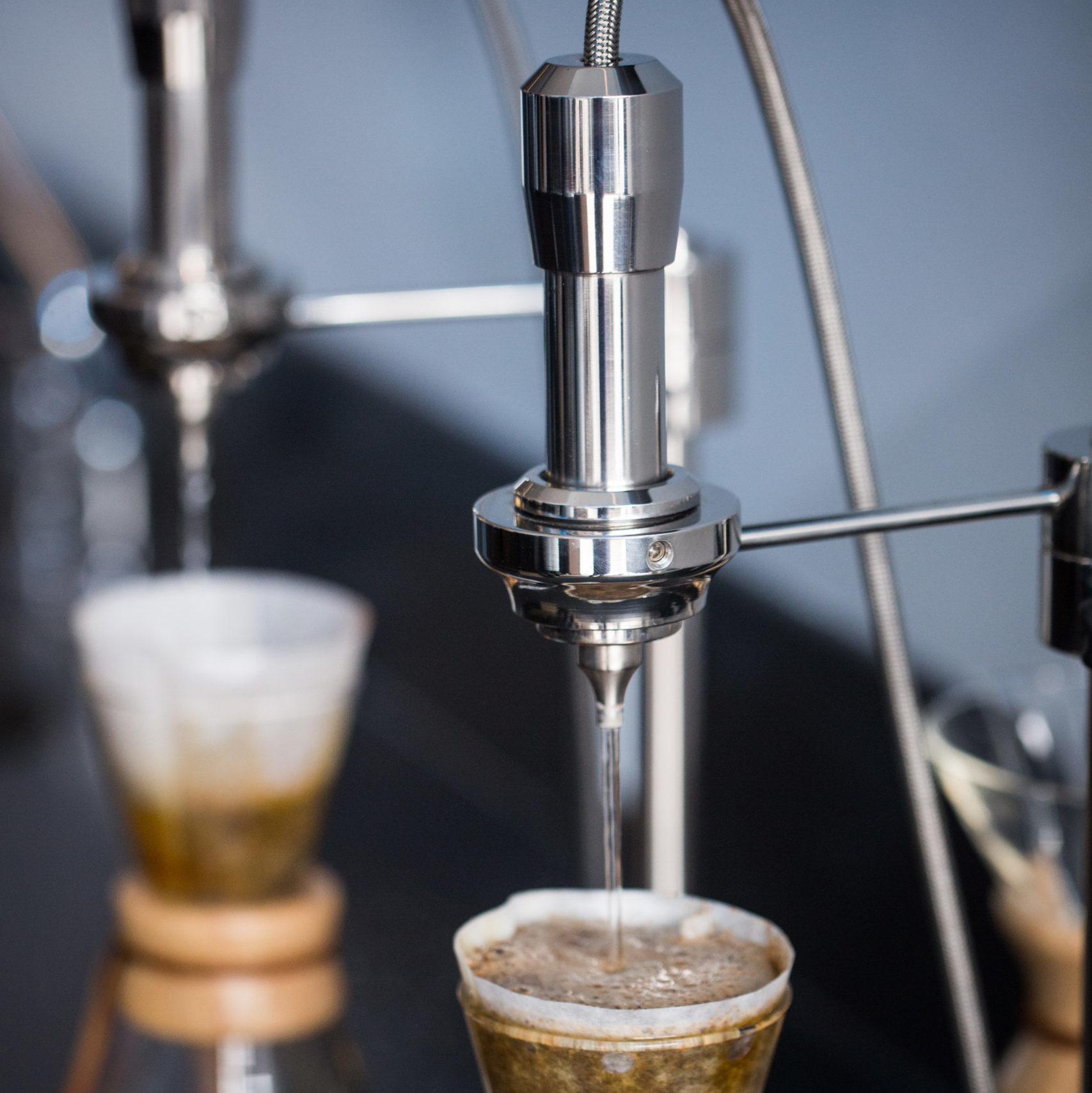The coffees that make the best pour overs are medium blends – the Wilder Blend as an example. Espresso beans can also be used, but single-origins do exceptionally well when brewed using the pour over method. Any of those lighter-to-medium roasts where you can get those delicious origin characteristics from the farm are great in the Chemex/pourovers!
GROUND COURCENESS
For the grind, you want it just a little bit finer than you would use in an Auto Drip – right in between a V-60 and a regular home drip brewer.
FILTER
The Chemex filters are twice as thick as your standard coffee filter, and they need to be thoroughly rinsed before use. So give that bad boy a nice rinsing. With a thicker filter you get a lot more flavor, but less body on the opposite end of the spectrum like you would with a French Press. Once you’ve rinsed your filter, make sure to pour that water out, tear your scale, and prepare for the pour.
CHEMEX VS V-60
Essentially, the only difference between a Chemex and a V-60 is the filter. Although there’s a lot of hoopla around the glass container it’s just a vessel for the filter, with nothing special about it other than the aesthetic design aspec. The filter thickness and size is what makes the biggest difference in terms of taste.
For a single-pour, I use roughly 25 grams of coffee and a water-to-coffee ratio of about 16:1. So 400-420 grams of water will do the trick.
FOR 2 SERVINGS:
1. Measure 40 grams or 3 tablespoons of beans.
2. Grind on a coarse setting, right below a French press gind.
3. Place filter into Chemex/hario v60 and rinse using boiling water.
4. Set Chemex/hario v60 on scale, add ground coffee, and tare scale.
5. Pour 80-100 grams of water just off the boil onto grounds until grounds are fully saturated.
6. Stir to break up any clumps in the grounds.
7. Allow the coffee to bloom for 45 seconds.
8. Pour in 100 gram pours until 670 grams is reached.
9. Strive to achieve a brew time of roughly 3:30.
10. Stir and serve.






THE FIRST POUR
My goal when conducting a pour over is to start the pour nice and slow in the middle, bringing it out and roughly doubling the weight of your grounds. So with 25 grams of coffee, you pour about 50 grams of water on top. Then let that bloom for about 30-40 seconds and give it a little stirring before the second pour.
THE SECOND POUR
Everyone has a different pouring style, but whichever you prefer, make sure that on the second pour, the kettle is nice and hot. Some people like the coffee bed to be nice and low, conducting short little pores every 10-20 seconds. Other people like to do a single big pour. Me personally, I like to wait until the water is just below that coffee bed, and the go hit it in two pours right after my first balloon, giving it a pretty aggressive stir there at the end to mix any of the top grounds that would hang onto the filter.
The timeframe we’re shooting for is in the range of about 3 to 3.5 minutes. The finer your grind, the slower it’ll flow through, so if you’re hitting a 2-minute extraction with 400 grams of water, it’s more than likely because the grind is too coarse. On the reverse, if you’re hitting a 5-minute brew time, you’ll need to adjust your grind to make it slightly coarser.
After the second pour, let the bloom develop, and then give it two more quick stirs. Once the water flows through, pull the filter off right before the last bit of water drips through, making sure to avoid any spilling or squishing
When you first pour your water on the ground, the coffee will literally swell up, and it’s basically just a rapid release of CO2 gas… to be technical. Using the size and intensity of the bloom, we’re able to see how fresh the coffee is. So if you pour your water on fresh beans (assuming that you grind the beans right before you brew), you should have a nice big bloom. Conversely, if you’re using coffee that’s three months old or more, the bloom will be flat, stale, and lifeless due to off-gassing.
Like with an aeropress, a V-60, or any sort of pour over that you do with the kettle, there’s always going to be a certain level of blooming. And even with an automatic machine, inside the brew basket, the coffee is blooming.
In fact, if the beans are super fresh and there are a lot of grounds in the basket, then you’ll get shops where the coffee boils up and out of the brew pot. I’ll get calls with people telling me that their coffee is overflowing, and I say to them that it’s a good thing, because it means the beans have just been roasted.


You’ll see a lot of professional home baristas with personal collections of prosumer coffee knick knacks, and people see this and wonder what my favorite method is for making a pour over. They might not be the sexiest, but commercial machines make the best pour overs. They’re consistent and remove all human error.
Better still than standard commercial coffee machines are modbars, which are basically machines with programmable spouts that water the grounds based on predetermined parameters that you input into the control board. The water temperature and pour speeds are controlled down to a fraction of a second, which takes the guesswork out of things and allows for ultimate control. Many folks swear by hand-done pour overs, but because no two pour overs are identical, the superior way to brew amazing coffee quickly and consistently is with a Modbar.